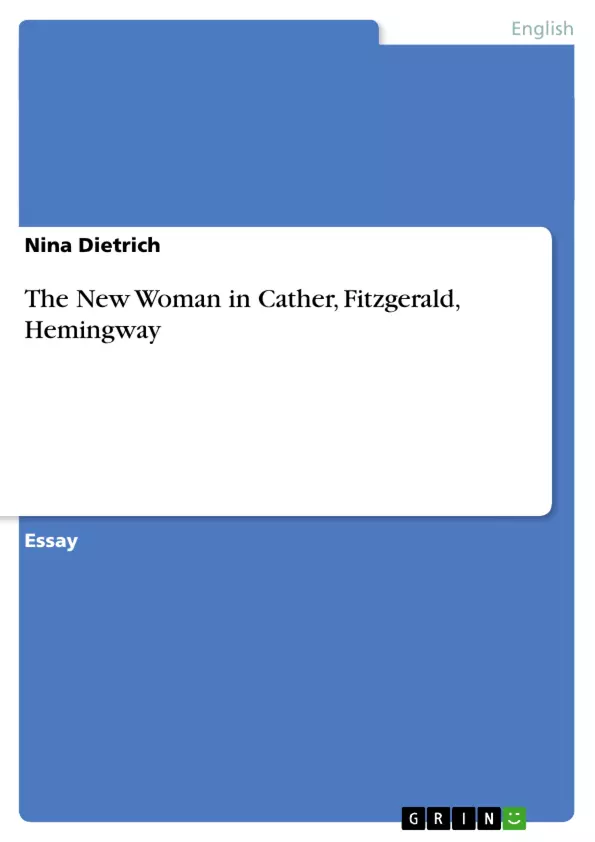The New Woman came into existence in the second half of the nineteenth
century, but remained nameless until 1894, when Ouida and Sarah Grand used the term
for the first time in two North American Review articles. Today, the New Woman is
generally seen as the manifestation of changing gender norms at the fin de siècle. Critics
such as Sally Ledger and Caroll Smith-Rosenberg differentiate between ‘first and
second- generation New Women: the first living and writing in the 1880s and 1890s, the
second in the 1920s and 1930s’ (Ledger 1). As this quotation shows, the label is mostly
applied to female authors. However, it can also be used to describe fictional characters
such as Lena Lingard in Willa Cather’s novel My Ántonia, Jordan Baker in Fitzgerald’s
The Great Gatsby, and Lady Brett Ashley in ‘Fiesta’ (The Sun Also Rises) by Ernest
Hemingway. This essay will, first of all, explain what was ‘new’ about women in the
late nineteenth and early twentieth century and thus attempt to define the term New
Woman. It will determine a number of characteristics that are considered typical of the
New Woman in fiction, and use these as criteria to examine whether the characters
mentioned above can be called New Women. Finally, the essay will compare the
manner in which Cather, Fitzgerald and Hemingway present the characters.
To begin with, the New Woman can generally be seen as a challenge to
conventional gender roles. There are three main areas in which the New Woman differs
from her predecessors: lifestyle, work and sexuality. That is, her attitude towards these
topics bears little or no resemblance to the attitude of the early nineteenth-century
woman.
Inhaltsverzeichnis (Table of Contents)
- Qu. 1: Examine the treatment in the literature of the period of the 'new woman'.
- The New Woman as a Challenge to Conventional Gender Roles
- Lifestyle and Fashion
- Work and Financial Independence
- Sexuality
- Lena Lingard in Willa Cather's My Ántonia
- Lifestyle
- Financial Independence
- Sexual Independence
- Jordan Baker in F. Scott Fitzgerald's The Great Gatsby
- Lifestyle
- Financial Independence
- Sexual Independence
- Lady Brett Ashley in Ernest Hemingway's The Sun Also Rises
- Lifestyle
- Financial Independence
- Sexual Independence
Zielsetzung und Themenschwerpunkte (Objectives and Key Themes)
This essay aims to explore the representation of the "New Woman" in American literature of the late nineteenth and early twentieth centuries. It will examine the characteristics of the New Woman, focusing on her lifestyle, work, and sexuality, and analyze how these characteristics are reflected in the fictional characters of Lena Lingard (My Ántonia), Jordan Baker (The Great Gatsby), and Lady Brett Ashley (The Sun Also Rises).
- The evolution of the "New Woman" concept in the late nineteenth and early twentieth centuries
- The role of gender norms and societal expectations in shaping the New Woman's identity
- The impact of changing social and economic conditions on women's lives and aspirations
- The portrayal of female characters in American literature of the period
- The relationship between individual agency and societal constraints in the lives of New Women
Zusammenfassung der Kapitel (Chapter Summaries)
The essay begins by defining the term "New Woman" and outlining the key characteristics that define her. These include a rejection of traditional gender roles, a focus on personal independence, and a more liberal attitude towards sexuality. The essay then delves into the analysis of Lena Lingard in Willa Cather's My Ántonia, examining her lifestyle, her ambition for financial independence, and her relationships with men. It then moves on to analyze Jordan Baker in F. Scott Fitzgerald's The Great Gatsby, focusing on her fashion, her career as a professional golfer, and her casual approach to relationships. Finally, the essay explores Lady Brett Ashley in Ernest Hemingway's The Sun Also Rises, examining her unconventional lifestyle, her financial independence, and her complicated relationships with men.
Schlüsselwörter (Keywords)
The central keywords and focus topics of this essay include: New Woman, American Modernism, gender roles, societal expectations, financial independence, sexual liberation, lifestyle, fashion, work, relationships, fiction, Willa Cather, F. Scott Fitzgerald, Ernest Hemingway, My Ántonia, The Great Gatsby, The Sun Also Rises.
- Quote paper
- Nina Dietrich (Author), 2003, The New Woman in Cather, Fitzgerald, Hemingway, Munich, GRIN Verlag, https://www.grin.com/document/19973



